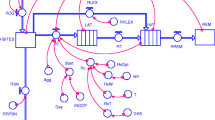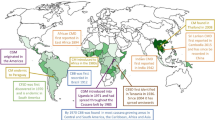Abstract
Existing spatiotemporal models for disease progress are unsuitable for describing epidemics of residue-borne diseases of cereals like crown rot, caused by Fusarium pseudograminearum, which increase in incidence over successive years and where inoculum has a fixed location. Monte Carlo simulation was used to explore the behaviour of a simple mechanistic model for crown rot, in which inoculum from each infected plant in one season came into contact with a defined number of plants in the following season. Contacted plants became infected according to a probability of infection that was less than 1. Growth chamber experiments confirmed that contact between infested residue and plants was required for infection. Observed features of epidemics at a long term trial site, including disease progress and maximum incidence, were satisfactorily fitted by simulations with a starting incidence of 4 %, 12 plants contacted by inoculum from each infected plant, and probability of infection of 0.66. This confirms that our understanding of disease behaviour at moderate to high levels of incidence is basically correct. However, infection rate between seasons was sensitive to initial incidence, suggesting that dispersal methods such as ascospores or conidia may be important at low incidence. A simple descriptive model was developed for the disease in bread wheat in the northern grains region of eastern Australia. Inoculum potential was estimated from the square root of the product of crown rot incidence and yield (a surrogate for biomass) of the preceding crop. Incidence of disease was related to inoculum potential by an infection constant. Crown rot inoculum was assumed to decline exponentially with time between susceptible crops. These two relationships were combined to predict the behaviour of the disease in different rotation systems. Over time, crown rot incidence converged to an equilibrium level that was determined by the infection constant, average yield, and the survival rate of inoculum. Modelled epidemics behaved in a way that was consistent with field data for continuous wheat, wheat-chickpea and wheat-sorghum rotations. This descriptive model could be used in extension or as a way of understanding how management and environment affect the disease.







Similar content being viewed by others
References
Akinsanmi OA, Backhouse D, Simpfendorfer S, Chakraborty S (2006) Genetic diversity of Australian Fusarium graminearum and F. pseudograminearum. Plant Pathol 55:494–504
Backhouse D (2006) Forecasting the risk of crown rot between successive wheat crops. Aust J Exp Agric 46:1499–1506
Barreto H, Howland FM (2006) Introductory econometrics: using Monte Carlo simulation with Microsoft Excel. Cambridge University Press, New York
Bentley AR, Leslie JF, Liew ECY, Burgess LW, Summerell BA (2008a) Genetic structure of Fusarium pseudograminearum populations from the Australian grain belt. Phytopathology 98:250–255
Bentley AR, Milgroom MG, Leslie JF, Summerell BA, Burgess LW (2009) Spatial aggregation in Fusarium pseudograminearum populations from the Australian grain belt. Plant Pathol 58:23–32
Bentley AR, Summerell BA, Burgess LW (2008b) Sexual compatibility in Fusarium pseudograminearum (Gibberella coronicola). Mycol Res 112:1101–1106
Booth RH, Taylor GS (1976) Fusarium diseases of cereals: XI. Growth and saprophytic activity of Fusarium nivale in soil. Trans Br Mycol Soc 66:77–83
Burgess LW, Backhouse D, Summerell BA, Pattison AB, Klein TA, Esdaile RJ, Ticehurst G (1993) Long-term effects of stubble management on the incidence of infection of wheat by Fusarium graminearum Schw. Group 1. Aust J Exp Agric 33:451–456
Burgess LW, Backhouse D, Summerell BA, Swan LJ (2001) Crown rot of wheat. In: Summerell BA, Leslie JF, Backhouse D, Bryden WL, Burgess LW (eds) Fusarium: Paul E. Nelson Memorial Symposium. APS Press, St Paul, MN, pp. 271–294
Burgess LW, Backhouse D, Swan LJ, Esdaile RJ (1996) Control of Fusarium crown rot of wheat by late stubble burning and rotation with sorghum. Australas Plant Pathol 25:229–233
Burgess LW, Klein TA, Bryden WL, Tobin NF (1987) Head blight of wheat caused by Fusarium graminearum Group 1 in New South Wales in 1983. Australas Plant Pathol 16:72–78
Dodman RL, Wildermuth GB (1987) Inoculation methods for assessing resistance in wheat to crown rot caused by Fusarium gramineum Group 1. Aust J Agr Res 38:473–486
Evans ML, Hollaway GJ, Dennis JI, Correll R, Wallwork H (2010) Crop sequence as a tool for managing populations of Fusarium pseudograminearum and F. culmorum in south-eastern Australia. Australas Plant Pathol 39:376–382
Felton WL, Marcellos H, Alston C, Martin RJ, Backhouse D, Burgess LW, Herridge DF (1998) Chickpea in wheat-based cropping systems of northern New South Wales. Influence on biomass, grain yield, crown rot in the wheat crop. Aust J Agr Res 49:401–407
Gilligan CA (1980) Zone of potential infection between host roots and inoculum units of the take-all fungus Gaeumannomyces graminis var. tritici. Soil Biol Biochem 12:513–514
Gosme M, Lucas P (2011) Effect of host and inoculum patterns on take-all disease of wheat incidence, severity and disease gradient. Eur J Plant Pathol 129:119–131
Hogg AC, Johnston RH, Dyer AT (2007) Applying real-time quantitative PCR to Fusarium crown rot of wheat. Plant Dis 91:1021–1028
Hogg AC, Johnston RH, Johnston JA, Klouser L, Kephart KD, Dyer AT (2010) Monitoring Fusarium crown rot populations in spring wheat residues using quantitative real-time polymerase chain reaction. Phytopathology 100:49–57
Kirkegaard JA, Simpfendorfer S, Holland J, Bambach R, Moore KJ, Rebetzke GJ (2004) Effect of previous crops on crown rot and yield of durum and bread wheat in northern NSW. Aust J Agr Res 55:321–334
Klein TA, Burgess LW, Ellison FW (1991) The incidence and spatial patterns of wheat plants infected by Fusarium graminearum Group 1 and the effect of crown rot on yield. Aust J Agr Res 42:399–407
Lakhesar DPS, Backhouse D, Kristiansen P (2010a) Accounting for periods of wetness in displacement of Fusarium pseudograminearum from cereal straw. Ann Appl Biol 157:91–98
Lakhesar DPS, Backhouse D, Kristiansen P (2010b) Nutritional constraints on displacement of Fusarium pseudograminearum from cereal straw by antagonists. Biol Control 55:241–247
Liddell CM (1985) The comparative pathogenicity of Fusarium graminearum Group 1, Fusarium culmorum and Fusarium crookwellense as crown, foot and root rot pathogens of wheat. Australas Plant Pathol 14:29–31
Mitter V, Francl LJ, Ali S, Simpfendorfer S, Chakraborty S (2006a) Ascosporic and conidial inoculum of Gibberella zeae play different roles in Fusarium head blight and crown rot of wheat in Australia and the USA. Australas Plant Pathol 35:441–452
Mitter V, Zhang MC, Liu CJ, Ghosh R, Ghosh M, Chakraborty S (2006b) A high-throughput glasshouse bioassay to detect crown rot resistance in wheat germplasm. Plant Pathol 55:433–441
Pettitt TR, Parry DW, Polley RW (1996) Effect of temperature on the incidence of nodal foot rot symptoms in winter wheat crops in England and Wales caused by Fusarium culmorum and Microdochium nivale. Agr Forest Meteorol 79:233–242
Scott JB, Chakraborty S (2010) Genotypic diversity in Fusarium pseudograminearum populations in Australian wheat fields. Plant Pathol 59:338–347
Scott JF, Farquharson RJ, Mullen JD (2004) Farming systems in the northern cropping region of NSW: an economic analysis. Economic Research Report. NSW Department of Primary Industries
Summerell BA, Burgess LW (1988) Stubble management practices and the survival of Fusarium graminearum Group 1 in wheat stubble residues. Australas Plant Pathol 17:88–93
Summerell BA, Burgess LW, Backhouse D, Bullock S, Swan LJ (2001) Natural occurrence of perithecia of Gibberella coronicola on wheat plants with crown rot in Australia. Australas Plant Pathol 30:353–356
Summerell BA, Burgess LW, Klein TA, Pattison AB (1990) Stubble management and the site of penetration of wheat by Fusarium graminearum Group 1. Phytopathol 80:877–879
Wearing AH, Burgess LW (1977) Distribution of Fusarium roseum ‘Graminearum’ Group 1 and its mode of survival in eastern Australian wheat belt soils. Trans Br Mycol Soc 69:429–442
Wildermuth GB, Thomas GA, Radford BJ, McNamara RB, Kelly A (1997) Crown rot and common root rot in wheat grown under different tillage and stubble treatments in southern Queensland, Australia. Soil Tillage Res 44:211–224
Willocquet L, Lebreton L, Sarniguet A, Lucas P (2008) Quantification of within-season focal spread of wheat take-all in relation to pathogen genotype and host spatial distribution. Plant Pathol 57:906–915
Xi K, Turkington TK, Chen MH (2008) Systemic stem infection by Fusarium species in barley and wheat. Can J Plant Pathol 30:588–594
Acknowledgments
This work was supported by Grains Research and Development Corporation project UNE62. Ian R. White is thanked for assistance with the growth chamber experiment.
Author information
Authors and Affiliations
Corresponding author
Rights and permissions
About this article
Cite this article
Backhouse, D. Modelling the behaviour of crown rot in wheat caused by Fusarium pseudograminearum . Australasian Plant Pathol. 43, 15–23 (2014). https://doi.org/10.1007/s13313-013-0247-6
Received:
Accepted:
Published:
Issue Date:
DOI: https://doi.org/10.1007/s13313-013-0247-6




